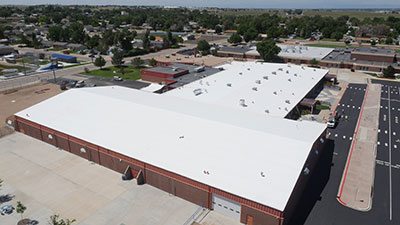A definition of TPO Roofing must start by understanding what a TPO membrane is.
Synthetic membranes are the new generation in the field of waterproofing. First launched in the 1970s and continuing to improve and stand up on the market, they have become increasingly popular due to outstanding performance in mechanical, chemical resistance (high durability) and quality-price ratio. TPO roofing is the newest form of synthetic membrane, perfected in the last two decades, after quite a long track record of revisions and improvements.
Why is waterproofing so important?
Every year, around the world, massive amounts of money are invested in public and private infrastructure, building projects… According to reports on damages in building structures, 80% of them are caused by waterproofing problems. In this context, investing in a high quality waterproofing solution not only protects the building elements against water penetration, but also ensures efficient resource use, low maintenance costs and high return on long-term investment.

A definition of TPO roofing: main benefits
TPO membrane is a material that combines the qualities of two of the most commonly used waterproofing materials: the flexibility of EPDM membranes with synthetic rubber and weldability of PVC membranes.
It is widely used by commercial roofer Denver contractors in roof construction (especially flat roofs) and also in underground engineering, for dams, tunnels, bridges etc., the material being very resistant and waterproof, stabilized against UV radiation. It is also flexible and easy to install even at low temperatures. The membrane is designed for roof protection on all types of buildings and structures. The aesthetic white color scheme is actually designed to be an ecological solution, making the roof reflective.
Besides being aesthetically pleasing, TPO roofing offers high protection against temperature changes, weathering, not to mention that the quality-price ratio is unbeatable.
A new installation method makes this membrane even more economical and greener, because it requires less adhesive. Note that it is easy to inspect this type of roof and make changes if necessary.
The TPO membrane has a very long life if it is properly installed. In addition, it looks particularly good in white, and remains a competitive product due to its price. These membranes are not attacked by insects, have high permeability to water vapor diffusion and do not require maintenance. Compared to other flat roofing materials, the TPO membrane is more durable and less polluting. Finally, it is recyclable at the end of its lifespan, which is a significant advantage. Thanks to their chemical composition, these types of membranes have almost unlimited resistance to ultraviolet rays, ozone and thermal shocks. Since these membranes do not contain plasticizers or fire resistance agents, their chemical characteristics remain stable and unchanged, thus demonstrating an exceptional durability translated into a long lifespan.
Disadvantages of a TPO roof
We cannot conclude our definition of TPO roofing without also mentioning the cons:
- TPO roofing requires a lot of energy for manufacturing
- your budget will need to be evaluated because this type of roof cover needs to be installed by competent people, specialized in this type of product.

